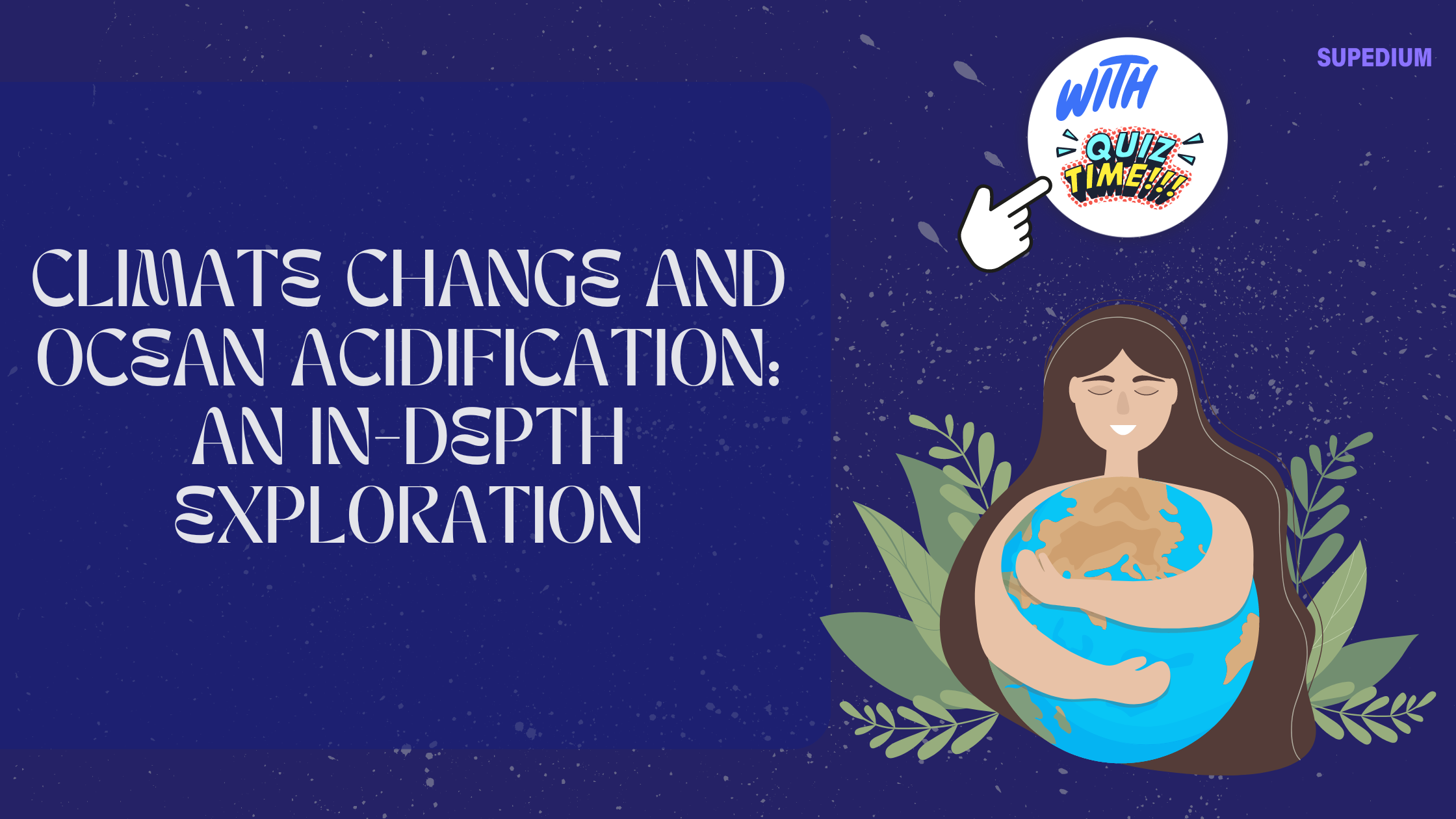Table of Contents
- 0.1 Introduction
- 0.2 The Science Behind Climate Change
- 0.3 The Science Behind Ocean Acidification
- 0.4 Interconnection Between Climate Change and Ocean Acidification
- 0.5 Ecological and Economic Consequences
- 0.6 Mitigation and Adaptation Strategies
- 0.7 Future Directions and Research
- 0.8 Conclusion
- 1 Quiz Time
![]()
Climate change and ocean acidification are two critical environmental challenges that are intricately linked, each exacerbating the impacts of the other. Understanding their interplay is essential for developing effective strategies to mitigate their effects on marine ecosystems and human societies.
Introduction
Climate Change
Climate change refers to long-term shifts in temperature and weather patterns, primarily driven by human activities such as burning fossil fuels, deforestation, and industrial processes. This has led to increased concentrations of greenhouse gases (GHGs) in the atmosphere, resulting in global warming. The primary greenhouse gases include carbon dioxide (CO2), methane (CH4), and nitrous oxide (N2O), each contributing to the greenhouse effect, which traps heat in the Earth’s atmosphere and leads to rising temperatures.
Ocean Acidification
Ocean acidification is the process by which the Earth’s oceans become more acidic due to increased atmospheric CO2. As CO2 levels rise, more of it dissolves in seawater, forming carbonic acid. This acid dissociates into hydrogen ions and bicarbonate ions, lowering the pH of the ocean and reducing the availability of carbonate ions that marine organisms need to form calcium carbonate shells and skeletons.
Understanding the relationship between climate change and ocean acidification is crucial due to their significant impacts on marine ecosystems and human economies.
The Science Behind Climate Change
Greenhouse Gases
Greenhouse gases are responsible for trapping heat in the Earth’s atmosphere. CO2, the most significant of these gases, is released from the combustion of fossil fuels, deforestation, and various industrial activities. Methane, another potent greenhouse gas, is emitted from agricultural practices, landfills, and livestock. Nitrous oxide, also a greenhouse gas, is produced from agricultural activities and industrial processes.
Mechanisms of Global Warming
The greenhouse effect occurs when GHGs absorb infrared radiation from the Earth’s surface, preventing it from escaping into space. This trapped heat warms the atmosphere. Positive feedback loops, such as the melting of polar ice reducing the Earth’s albedo (reflectivity), and negative feedback loops, such as increased cloud cover reflecting sunlight, influence the extent of warming.
Observed Impacts
Global temperatures have risen significantly over the past century, with notable effects such as melting ice caps and glaciers, leading to rising sea levels. Altered weather patterns have increased the frequency and intensity of extreme weather events, including storms, droughts, and heatwaves.
The Science Behind Ocean Acidification
Chemical Process
Ocean acidification begins with the absorption of CO2 by seawater, where it reacts with water to form carbonic acid. This acid further dissociates into hydrogen ions and bicarbonate ions. The increase in hydrogen ions lowers the pH of seawater, making it more acidic. The concentration of carbonate ions, which are crucial for calcifying organisms, decreases as a result.
Measurement and Monitoring
Ocean acidity is monitored through pH measurements and the tracking of carbonate ion concentrations. Advanced technologies, including buoy systems and research vessels equipped with sensors, allow scientists to gather data on ocean chemistry and assess trends over time.
Observed Impacts
The increased acidity of oceans has profound effects on marine organisms, particularly those that rely on calcium carbonate for their shells and skeletons. Coral reefs, shellfish, and mollusks face challenges in maintaining their structures, leading to disruptions in marine ecosystems.
Interconnection Between Climate Change and Ocean Acidification
Shared Origin of CO2 Emissions
Both climate change and ocean acidification stem from increased atmospheric CO2 levels. The same emissions that drive global warming also contribute to ocean acidification. This dual impact intensifies the stress on marine environments.
Combined Impacts on Marine Ecosystems
The synergistic effects of climate change and ocean acidification are profound. Rising sea temperatures, caused by global warming, stress marine organisms and disrupt ecosystems. Ocean acidification exacerbates these stresses by affecting organisms’ ability to build and maintain calcium carbonate structures, which are crucial for many marine species.
Ecological and Economic Consequences
Impact on Marine Life
Coral reefs, often referred to as the “rainforests of the sea,” are particularly vulnerable. The increased acidity reduces coral calcification rates, leading to weakened structures and reduced biodiversity. Shellfish and mollusks, such as oysters and clams, experience thinner and weaker shells, affecting their survival and reproduction. Fish species may also suffer from altered behaviors and physiology due to changing environmental conditions.
Economic Implications
The impacts on marine life have significant economic consequences. Fisheries and aquaculture industries face challenges as key species decline or become less viable. Coral reef degradation affects tourism, as these ecosystems attract millions of visitors annually. Additionally, the loss of coastal ecosystems reduces natural protection against storms and erosion, impacting coastal communities and infrastructure.
Mitigation and Adaptation Strategies
Reducing CO2 Emissions
Addressing the root cause of climate change and ocean acidification involves reducing CO2 emissions. This can be achieved through transitioning to renewable energy sources, improving energy efficiency, and enhancing conservation efforts. Reforestation and afforestation also play a role in sequestering carbon dioxide from the atmosphere.
Ocean-Specific Actions
To combat ocean acidification, specific actions include establishing marine protected areas to safeguard critical habitats, restoring coral reefs and other important marine ecosystems, and investing in research and monitoring to better understand and address the effects of acidification.
Policy and International Cooperation
International agreements, such as the Paris Agreement, aim to limit global warming and, indirectly, mitigate ocean acidification. National and local policies that address emissions and protect marine environments are essential. Public awareness and scientific research are crucial for informed decision-making and effective action.
Future Directions and Research
Advances in Climate Science
Ongoing improvements in climate models enhance our understanding of long-term impacts and feedback mechanisms. These advancements help predict future climate scenarios and inform mitigation strategies.
Innovations in Ocean Chemistry Research
New technologies for measuring ocean chemistry, combined with experimental studies on marine organisms, provide valuable insights into the effects of acidification and potential adaptation strategies.
Role of Technology and Innovation
Technological innovations, such as carbon capture and storage, and geoengineering possibilities, offer potential solutions for reducing atmospheric CO2 and mitigating its impacts on oceans.
Conclusion
In summary, climate change and ocean acidification are deeply interconnected issues with far-reaching impacts on marine ecosystems and human societies. Addressing these challenges requires a comprehensive approach that includes reducing greenhouse gas emissions, implementing targeted ocean protection measures, and fostering international cooperation. Continued research and innovation will be vital in developing effective strategies to mitigate these environmental threats and protect the health of our planet’s oceans.






Be the first to comment